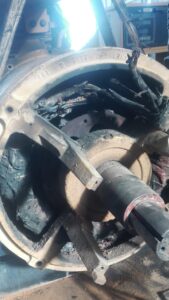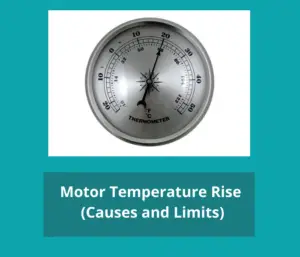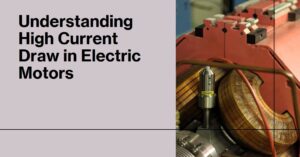A space heater in a motor or electrical panel is a small heating device designed to prevent moisture condensation inside the motor or the panel’s enclosure
A thermostat or temperature controller regulates the heater, activating it as needed to prevent condensation and keep the motor’s temperature within the desired range, ensuring safe and reliable operation.
Table of Contents
What is a Space Heater in a Motor And Electric Panels?
A space heater in a motor or electrical panel is a small heating device designed to prevent moisture condensation inside the motor or the panel’s enclosure. These heaters play a crucial role in maintaining the reliability and longevity of equipment, particularly in environments where temperature fluctuations or high humidity levels are common.
Purpose of Space Heaters:
- Moisture Prevention: When motors or panels cool down, moisture in the air can condense inside the enclosure. This condensation can lead to:
- Corrosion of internal components.
- Insulation degradation.
- Electrical short circuits.
- Temperature Regulation: Space heaters maintain a slightly elevated temperature inside the enclosure, preventing dew point conditions that cause condensation.
- Enhanced Equipment Life: By reducing the risk of corrosion and electrical issues, space heaters help extend the operational life of the motor or panel.

Working principle of motor space heater
1. Heating Element:
- Resistive Heating: Space heaters are made of resistive materials, like nichrome wire or PTC (Positive Temperature Coefficient) ceramics. When electricity flows through the heater, it encounters resistance, converting electrical energy into heat.
- Low Power: These heaters are designed to consume minimal energy, typically ranging from a few watts to a few hundred watts, depending on the size of the motor or panel.
2. Activation Conditions:
- Idle or Off State:
- When a motor is not running, or the electrical panel is inactive, the temperature inside can drop. This can lead to moisture condensing on internal surfaces. The space heater prevents this by maintaining a slightly elevated temperature.
- Low Ambient Temperature:
- In cold environments, even active equipment can experience condensation when temperatures fluctuate. The heater helps stabilize internal conditions.
3. Control Methods:
-
Manual Control:
- In some setups, the heater is switched on and off manually by an operator. This method is simple but requires human intervention.
-
Thermostatic Control:
- A thermostat is installed alongside the space heater to automate its operation. The thermostat monitors the internal temperature of the motor or panel and switches the heater on if the temperature drops below a set threshold (e.g., 10°C or 50°F).
- Once the desired temperature is reached, the thermostat turns off the heater to save energy.
-
Automated Systems:
- In advanced setups, space heaters are integrated into a control system that monitors ambient temperature, humidity, or equipment status.
- For instance:
- Humidity Sensors: The heater activates when humidity levels rise above a critical value, preventing condensation before it occurs.
- Operational Sensors: Some systems link the heater to the motor’s status. The heater automatically turns on when the motor is off and turns off when the motor starts running.
4. Safety Features:
- Overheat Protection:
- Most space heaters have built-in mechanisms, like thermal cut-offs, to prevent overheating.
- Low Voltage Design:
- To reduce risks, space heaters often operate at low voltages (e.g., 24V or 48V) or are insulated to prevent electrical hazards.
Summary:
Space heaters work by gently raising the temperature inside a motor or panel to combat condensation. Their operation is often automated through thermostats or humidity sensors to ensure reliable performance without excessive energy consumption. By keeping conditions stable, they play a vital role in preventing damage and extending equipment life.
Safety tip for working with anti-condensation heater
As mentioned above the heater has its own power source. i.e. its power is not the same source as the panel or the motor.
This makes it tricky when you need to electrically isolate the panel for maintenance or inspection. You should pay attention to the right isolation of the heater.
Don’t just isolate the panel power source main circuit breaker.
Let me share a story that taught me a lesson I’ll never forget.
I was working on a medium-voltage panel that had a space heater inside. What I didn’t realize at the time was that the space heater had its own power source—separate from the main panel.
Things took a risky turn. My boss, who happened to be working alongside us, accidentally touched a live wire from the heater and got an electric shock! Thankfully, he released it quickly and was unharmed.
Here’s the surprising part: my boss didn’t get angry or punish me for the oversight. But the incident left me with a valuable lesson: always double-check power sources before starting any work.
Not all bosses might be as forgiving, and safety should always come first. So, learn from my mistake—double-check, stay alert, and most importantly, stay safe!
Motor Space Heater Voltage Drop
In many cases, the motor power source and starter are located away from the motor itself. As the space heater voltage is usually 220V or 110V, this distance may cause some voltage drop in the space heater.
The question is what will happen? Will the space heater voltage drop affect its efficiency?
The answer is, that the space heater voltage drop will of course affect its heating ability. But it still working. It will need a longer time to heat the space of the motor or the panel.
It’s a heater, not a motor. I mean it has no starting current. It will work on any voltage. But you should check its user guide data and make sure to keep this voltage within allowable limits.
Motor anti-condensation heater resistance calculation
Motor anti-condensation heater resistance is just like any other resistive load. You can measure it with a multi meter. The value varies from one to one.
The motor or the panel nameplate should tell you the motor’s anti-condensation heater resistance. If the value is not on the nameplate, then you will find the voltage and the power of the heater. As the heater has no power factor, then you can calculate its resistance by applying the formula
R = V2 / P
While:
- R is the space heater resistance.
- V is the space heater operating voltage.
- P is the power in watts.
Example
If the motor space heater is 500 watts and its voltage is 110 V then its resistance is 1102/500 = 24.2 Ohm
Do all Motors and Panels Have a Space Heater?
No, not all motors and electrical panels have space heaters. The use of space heaters in motors and panels depends on various factors, including the specific application, environmental conditions, and the need for temperature control.
Factors Influencing the Use of Space Heaters in Motors and Panels:
-
Environmental Conditions:
Space heaters are commonly used in motors and panels installed in harsh environments, such as outdoor locations, cold climates, or areas with high humidity. These conditions increase the risk of condensation, which space heaters help prevent by maintaining a stable internal temperature. -
Motor Size:
The inclusion of space heaters in motors often depends on the motor’s size and application. Larger motors, particularly those in industrial settings, are more likely to have space heaters to ensure proper temperature control during idle periods. -
Panel Size and Components:
In electrical panels, the use of space heaters is influenced by the panel’s size and the sensitivity of its components. Large panels with critical or delicate equipment are more likely to include space heaters to safeguard against moisture and temperature-related issues. -
Application Importance:
For applications where equipment uptime is critical, space heaters are essential. They help maintain optimal operating conditions, reducing the risk of malfunctions or downtime due to temperature fluctuations. -
Local Climate Factors:
The necessity of space heaters also depends on the local climate. In regions with extreme temperature variations, space heaters are more commonly used to protect equipment from the effects of cold or damp conditions. -
Design Specifications:
The decision to include space heaters is based on the equipment’s design and purpose. Engineers and designers evaluate environmental factors, operational criticality, and equipment standards to determine whether space heaters are required.
Don’t Leave Empty-Handed!
Install my Free Android App on Google Play:
Electrical Cables Most Common Tables “Cables Tables”
And, my Electrical Calculations App “Fast Electrical Calculator”
Discover more great content by subscribing to My channel
Looking to stay ahead of the game in the world of electrical engineering? Subscribe to my YouTube channel and gain access to exclusive content you won’t find anywhere else!
The staff I recommend
(Amazon Affiliate Links to products I believe are high quality):
- Economy 120 Volt/60Hz AC Power Source – Step-Down Voltage & Frequency Converters 1800W
- UNI-T Digital Multimeter Tester UT139C
- 50-Amp Extension Cord for RV “100ft”
- Voltage Stabilizer 110/220v
- Hair Dryer “best selling“
- TOSHIBA EM131A5C-BS Countertop Microwave Ovens
Disclaimer: This contains affiliate links to Amazon products. I may earn a commission for purchases made through these links.


